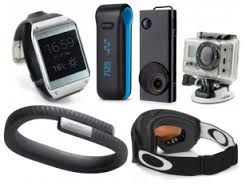A new forecast from IDC has predicted that smartwatches, fitness trackers and other wearables are rising fast.
This year, the International Data Corporation (IDC) reported a massive surge in the wearable technology market, which it said saw growth of 300 percent due to the sale of products such as the Fitbit Surge, Apple Watch and Pebble Time.
The IDC has released a report saying that by the end of 2016, worldwide shipments will hit 111.1 million.
That will mean that wearable technology will have seen an increase of 44 percent over the figure from 2015. That said, by the year 2019, shipments of wearables will have broken through the 214.6 million mark. According to the wearables team research manager at IDC, Ramon Llamas, “In a short amount of time, smartwatches have evolved from being extensions of the smartphone to wearable computers capable of communications, notifications, applications, and numerous other functionalities.”
It was also pointed out that wearable technology devices are experiencing a rapid evolution.
 Llamas went on to point out that just because they’re starting to sell and they will be seeing rapid growth over coming years, it doesn’t mean that the smartwatches we currently know will be the ones that actually take off over the next few years. He explained that “The smartwatch we have today will look nothing like the smartwatch we will see in the future.”
Llamas went on to point out that just because they’re starting to sell and they will be seeing rapid growth over coming years, it doesn’t mean that the smartwatches we currently know will be the ones that actually take off over the next few years. He explained that “The smartwatch we have today will look nothing like the smartwatch we will see in the future.”
He also underscored the forecast that the details of these devices will be quite different from what we currently see. The health sensors, cellular connectivity and even the wearables app market – which is already rapidly on the grow – will be ready to provide serious game changing evolutions in this market. Llamas feels that it will be in those areas that the gadgets will start to define themselves as having value and will become appealing to consumers.
While many of its predictions aligned well with other reports that have been issued by various prediction firms, the IDC report was somewhat different in that it has said that watchOS and Android Wear will be grabbing the top two spots (respectively). That said, it also stated that Tizen from Samsung will carve out an important segment of the market over the next four years, as well, to the point that it might swipe away some of the share that would otherwise have belonged to Android Wear.
Some people feel that older smartphones offer them everything they need and are holding off upgrades.
The mobile technology industry’s smartphone segment is watching its sales slowing and it has been trying very hard to help to make sure consumers burn through their present devices as fast as they can so they will replace them with something new.
However, there is a chunk of the consumer market that isn’t interested in all the latest bells and whistles.
Despite the fact that carrying older forms of mobile technology, such as smartphones that are older than a couple of years or so, there is a sizeable group of consumers who aren’t taken in by all the efforts the smartphone industry is making to try to push them to drop their old tech in favor of larger screens, touchscreens without physical keyboards, or even non-flip phone designs. There are many different reasons that people are choosing to hang on to their older devices instead of upgrading – even when their mobile providers try to woo them with great upgrade deals in order to stick around with them for another year or two.
Many people find that they reach the point that they know and love the mobile technology they have.
 These individuals find that their devices perform all the tasks they need to complete and it stops them from handing even more of their lives over to a device they must carry around all the time.
These individuals find that their devices perform all the tasks they need to complete and it stops them from handing even more of their lives over to a device they must carry around all the time.
The truth of the matter is that over 90 percent of smartphone owners change models within every span of two years. This, according to Ramon Llamas of IDC mobile phone trend tracking research firm. That said, there is a small but meaningful percentage of the population that is hanging onto their phones for three, four years or more.
While some people don’t want their devices to be as large as today’s typical offerings, others say that they aren’t actually all that impressed with the features currently being offered and they don’t see any reason to sign on to a new contract or hand over hundreds of dollars when their current mobile devices are still working.
Eventually, all mobile technology does need to be replaced in order to keep up with current standards, but it will be interesting to watch the replacement rates over years to come, and to see if people continue to want the latest or if they begin to hang on to what they already have as the novelty of novelty wears off.
 Llamas went on to point out that just because they’re starting to sell and they will be seeing rapid growth over coming years, it doesn’t mean that the smartwatches we currently know will be the ones that actually take off over the next few years. He explained that “The smartwatch we have today will look nothing like the smartwatch we will see in the future.”
Llamas went on to point out that just because they’re starting to sell and they will be seeing rapid growth over coming years, it doesn’t mean that the smartwatches we currently know will be the ones that actually take off over the next few years. He explained that “The smartwatch we have today will look nothing like the smartwatch we will see in the future.”
 These individuals find that their devices perform all the tasks they need to complete and it stops them from handing even more of their lives over to a device they must carry around all the time.
These individuals find that their devices perform all the tasks they need to complete and it stops them from handing even more of their lives over to a device they must carry around all the time.